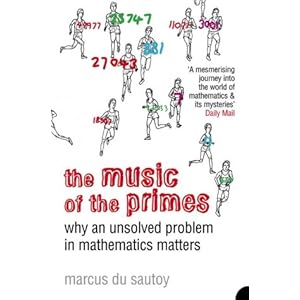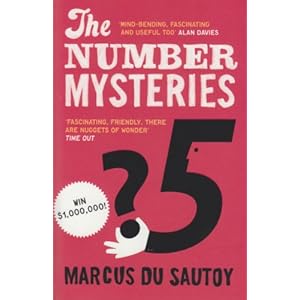- This topic has 16 replies, 10 voices, and was last updated 12 years ago by wors.
-
The Code
-
worsFull MemberPosted 12 years ago
anyone watch it?
What was the equation the guy used to calculate the maximum size of fish that fisherman caught ever based on his catch that day?
JolsaFull MemberPosted 12 years agoIt had an f in it I think.
f = something divided by (something multiplied by Pi and something else).
Hope that helps.
RealManFree MemberPosted 12 years agoWhat was the equation the guy used to calculate the maximum size of fish that fisherman caught ever based on his catch that day?
If that’s true, it doesn’t make any sense.
StonerFree MemberPosted 12 years agonormal distribution equation
The program is OK if maths is a bit of a mystery to you. Otherwise it’s a little bit low brow Im afraid.
Id recommend reading his books instead as you can move through the topics much faster than he does in the program
JolsaFull MemberPosted 12 years agoThe program is OK if maths is a bit of a mystery to you. Otherwise it’s a little bit low brow Im afraid
Surely I get points for remembering there was an f in it? 😀
djgloverFree MemberPosted 12 years agoIt might be low brow (to you) in terms of content, but its the production that makes in good viewing IMO. More engaging than watching some beardy bloke with NHS specs and a flipboard.
deadlydarcyFree MemberPosted 12 years agoIt might be low brow
Well to be fair, Stoner was never going to say something like “Well, it was pitched perfectly for my intellectual level” was he? 🙂
StonerFree MemberPosted 12 years agoIt might be low brow
pitched perfectly for my intellectual level
not mutually exclusive 🙂
StonerFree MemberPosted 12 years agoanyway, I didnt quite mean “low brow” I meant they spend too much time repeating the same woolly statements about “magic in the numbers” and fancy graphics with thoughtful cutaways and music instead of delving a little deeper into the functions of the mathematical phenomena he’s talking about.
case in point: the fish catch weighing and application of the normal distribution. Would have been far more informative to have covered WHY pi occurs in the normal function and how it’s used – that would probably have helped Wors remember what the function was…
deadlydarcyFree MemberPosted 12 years ago😀
Seriously though…I did enjoy it…although the constant references to “the code” were slightly tiring. You can’t but be buoyed by his enthusiasm though can you? It’s got to be a difficult one once you start getting onto chaos theory, the basics of which flummox me TBH – and have to keep it at a level where even brainboxes like you won’t switch off 😉
EDIT
WHY pi occurs in the normal function and how it’s used
Aye, tru dat. I was a bit annoyed that he just talked about pi without really explaining it in any depth. And the constant repetition of stuff, as you say, gets a bit boring.
maccruiskeenFull MemberPosted 12 years agoAnd the constant repetition of stuff, as you say, gets a bit boring.
That’s the fractals isn’t? 🙂
I only caught a few bits, premise seemed to be that arcane mathematical nicknacks have mysteriously been hidden inside the working bits of nature. I thought the whole point of maths is that it’s a language to describe the natural world…. And do vat returns.
chugg08Full MemberPosted 12 years ago…okay I’ll ask
Why does pi occur in the normal distribution equation?
StonerFree MemberPosted 12 years agohttp://www.quora.com/Why-is-pi-in-the-normal-distribution
but very simply: there’s a relationship between the way the normal distribution curve is mathematically defined and how circles can be defined so you can use descriptive maths of circles (which are of course derided from pi) to describe the shape of the normal curve.
(this bit: Since x2 + y2 is the squared distance from the origin to the point (x, y), this function is constant on each circle of radius r centered at the origin)The other question of course, is why is the normal distribution curve shaped the way it is in the first place? And that’s described by the Central Limit Theorem, “In probability theory, the central limit theorem (CLT) states conditions under which the mean of a sufficiently large number of independent random variables, each with finite mean and variance, will be approximately normally distributed”
the important bit of which is : “The central limit theorem (in its common form) requires the random variables to be identically distributed.”
http://en.wikipedia.org/wiki/Central_limit_theorem
A simpler decription in that link is:
Forget about the exponential part of the distribution for a moment and focus on the: 1/sqrt2pi
This is equivalent to the radius of a circle whose area is 1/2. Since we know we need to create a distribution that is symmetric about the y-axis we know we need the area under the curve to be 1/2 on each side.
Therefore, and perhaps this is a little simplistic, we can think of exp( -x^2 / 2) as a transformation of the unit circle (circle around (0,0) with area 1 and radius 1/sqrt(pi) ).
In other words, we are stretching a circle infinitely across the x-axis while maintaining an area under the curve of 1, a maximum y value at x=0, and a exponential curve to fit it all together.
and more here
http://math.stackexchange.com/questions/28558/what-do-pi-and-e-stand-for-in-the-normal-distribution-formulaphilconsequenceFree MemberPosted 12 years agoi’ve got this all saved on the sky plus so i can watch it all in one session now mrsconsequence is away on holiday.
will all this pie make me fatter? 😳
The topic ‘The Code’ is closed to new replies.


